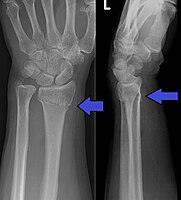
Photo from wikipedia
Patient-Reported Outcome Measures (PROMs) gain growing attention. The Food and Drug Administration suggested in 2009 to have PROMs for every new treatment and technology. The use of PROMs was further… Click to show full abstract
Patient-Reported Outcome Measures (PROMs) gain growing attention. The Food and Drug Administration suggested in 2009 to have PROMs for every new treatment and technology. The use of PROMs was further promoted by the Patient Protection and Affordable Care Act of 2010 in the USA. Recommendations from other national and international organizations include the OECD's Project of Patient-Reported Indicator Surveys (PaRIS) and the International Consortium for Health Outcomes Measurement (ICHOM). Our development and initiation of a Fracture Database started early in 2018. We orientated our database on the role model of the Swedish Fracture Registry. REDCap (Research Electronic Data Capture) is a web interface for a SQL (Structured Query Language)-Database. We used it to program the Fracture Registry. We collect data about demographics, diagnosis, treatment, adverse events, clinical outcomes, and PROMs. The PROMS are recorded with the Software 'Heartbeat ONE' vs. 6.15.4. Inclusion criteria are all patients with fractures of the upper and lower extremity, including the pelvis and multiple injuries, treated surgically. Excluded are all patients with fractures of the hand as monotrauma and non-surgical treatment. We established questionnaire sets for each anatomical region. Every hospitalized patient is screened for inclusion criteria to get the baseline PROMs. Follow-up PROMs are collected at 3-months and 12-months in our outpatient clinic. In five months of collecting PROMs, we have evaluated 599 patients, 521 fulfilling the inclusion criteria. 329 (63%) questionnaire sets were completed. The mean time for answering the questions was 11-20 minutes. The input rate of 63% for PROMs accounts for the start of the process, with 22 (4%) patients being dismissed before answering the questionnaires. 93 (18%) patients denied participation. 52 (10%) patients were not able to participate (dementia, delirium). Other causes for missing data were language barriers (n = 28; 5%), medical reasons like polytraumatized patients (n = 4; 0.8%), and deceased patients (n = 15; 2.9%). Most Orthopaedic Trauma centers publish data about PROMs from surgically treated patients. Starting in the first quarter of 2021, we will include non-surgically treated patients. We have optimized the process of including patients. Our aim is a response rate of more than 80% within this year to get representing data.
Journal Title: British Journal of Surgery
Year Published: 2021
Link to full text (if available)
Share on Social Media: Sign Up to like & get
recommendations!